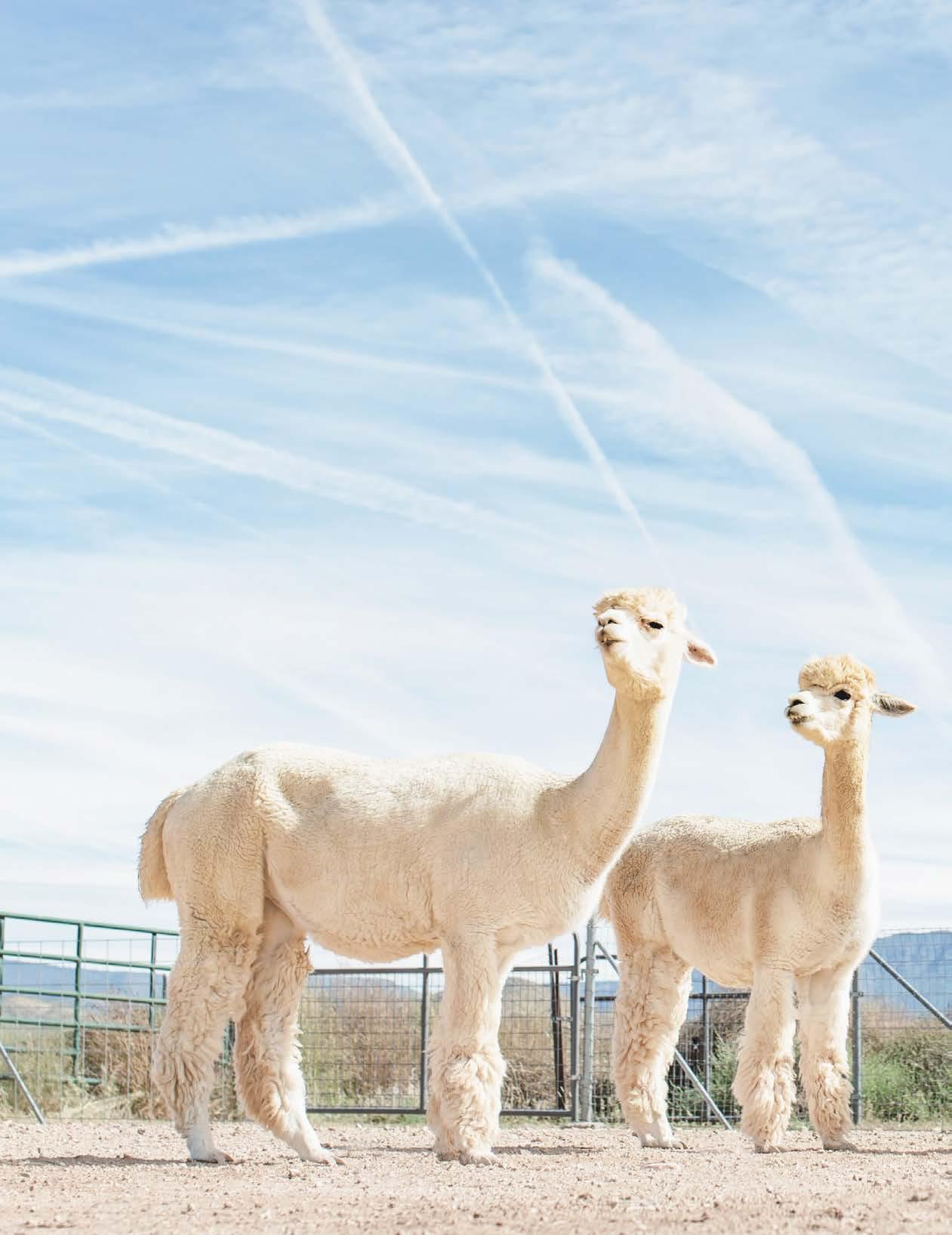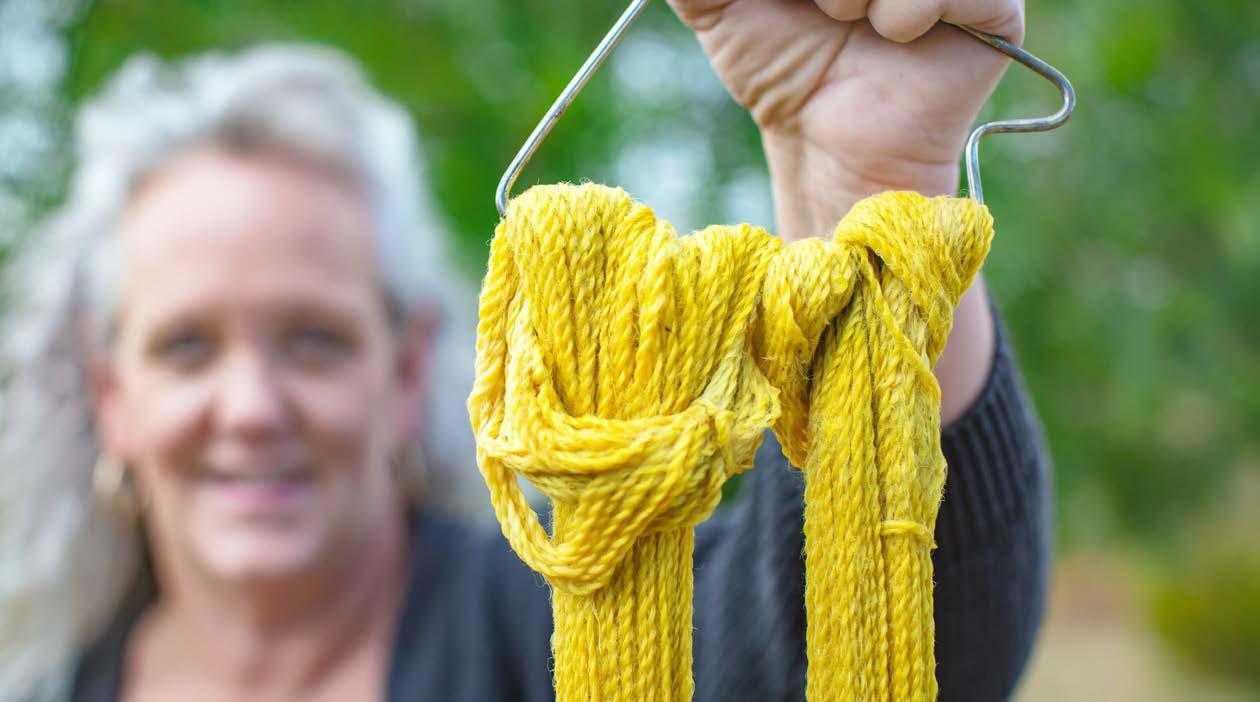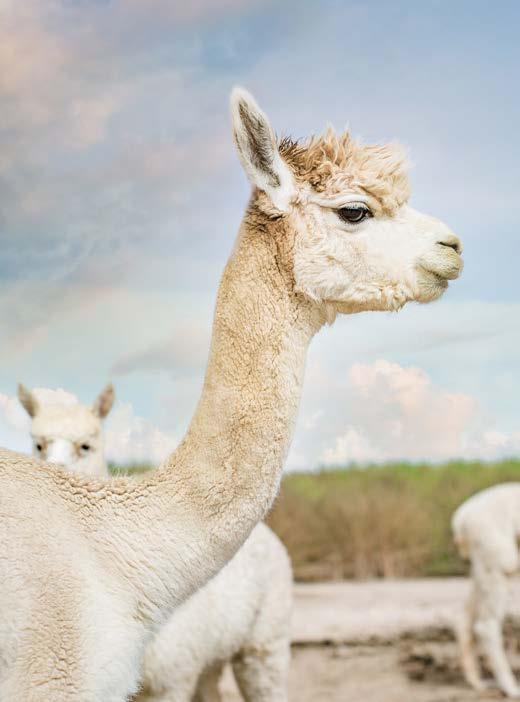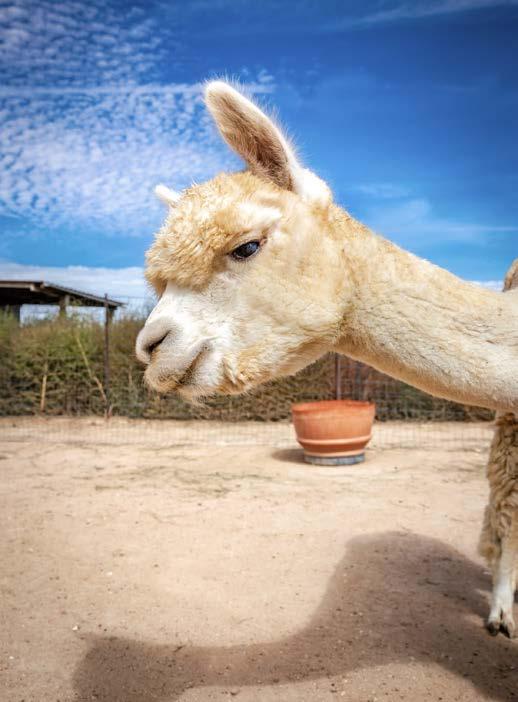
9 minute read
Adventures with Alpacas
By Angie Johnson-Schmit
When Wendy Dittbrenner decided in 1998 that farm living was indeed the life for her, she purchased a 10-acre plot of land in Prescott Valley, Arizona. “I knew with 10 acres, you do something,” she said. She started researching what she could raise or grow on her parcel of land. She fell in love with alpacas after seeing a photo of one in a magazine. “I saw the face and thought it was cute,” she said. Intrigued, she switched her research focus to alpacas.
Dittbrenner soon realized alpacas were exactly what she had been looking for. Closely related to llamas but much smaller, alpacas are raised for their thick, fluffy coats. This natural fiber is what the animals were originally bred for in South America and is used to make everything from blankets and sweaters to shoe inserts. The fiber is light, warm, soft, and highly valued. Alpacas are relatively easy to care for. The "cute factor" is a bonus.
After talking to another woman in the Coyote Springs area who raised alpacas and spending time with the animals, Dittbrenner was convinced. “You did not have to milk them once or twice a day and I didn’t have to slaughter them for meat,” she said. “They live for a good long time and all you have to do is give them an annual haircut and I thought that was very reasonable.”

Photocredit: Blushing Cactus Photography
Peaceful Prairie Alpaca Ranch began when Dittbrenner bought her first alpaca sight unseen from an owner in Idaho. She learned a lot from her first alpacas and dove even deeper into learning how to raise and care for them. With a 15-to-20-year lifespan, it was important to her to provide the best care possible for her herd. One thing she learned quickly was that while alpacas share some similarities with livestock commonly found in this religion, they are quite different from sheep and goats. “Believe it or not, the veterinary care was here at that time,” said Dittbrenner. She credits Chino Valley, Arizona veterinarian Leonda Armstrong with providing good veterinary care for her animals. While she has named each of the alpacas she keeps and speaks of them with genuine affections, Dittbrenner is very clear that she is not running a petting zoo. She loves raising alpacas, but she also wants interested visitors to understand that it’s a job. “I think it’s important to share what it is and what it looks like, the good and the bad.”
Dittbrenner soon became known as a woman who knows her alpacas and is currently a board member of the national Alpaca Owners Association. Between her own animals and alpacas brought in for breeding and boarding, Dittbrenner has frequently had over 100 alpacas at the ranch. “It was actually at 120 for a while,” she said. “We were feeding five to seven bales of hay a day at our peak.”
She currently has about 30 alpacas at Peaceful Prairie and is happy with keeping that number relatively low.
“I love what I’m growing, but now we can’t find that much hay,” she said. “It’s hard to get, hard to source.” Ditbrenner feeds her alpacas orchard grass hay, noting “they need a grass hay with a protein content that supports their fiber growth.” With animals depending on her for their feed, ensuring a reliable hay source is an important consideration.

Dittbrenner cares for and breeds her alpacas with an eye toward improving fleece quality. All her research and work has resulted in a consistently high fiber quality that she is justifiably proud of. As a result, she has what she feels is a superior quality product with fewer of the coarser “guard” hairs. This means her fleece has more of the valuable long, soft hair used to make high-end yarn.
She believes alpacas are “easy keepers,” but like any form of ranching or agriculture, it is not an easy lifestyle. “There is no Netflix and soup during a snowstorm,” she said. Regardless of bad weather or personal illness, the animals need to be fed, watered, and cared for every day. “The flip side is I think that’s good for us,” said Dittbrenner. “That pushes me in a way that I think is ultimately good.”
All of this hard work is done with one goal in mind: producing a quality alpaca fleece that can be felted or made into yarn.
Five times warmer than just about any other natural fiber, alpaca fiber is also less itchy than wool due to its lack of lanolin. The strong, supple fiber dyes easily and comes in a wide range of natural colors, making it one of the most sought-after natural fibers in the textile industry.
On shearing day, Dittbrenner holds proof in her hands that a year’s worth of care has yielded the results she is looking for. Frequently shearing day at Peaceful Prairie is also a social event for Dittbrenner and other local alpaca owners. “We have a great time with friends,” she said. “Other people bring their alpacas here to shear and if they only have a few, we crank up the music and have a blast.”
Dittbrenner thinks the alpacas appreciate getting sheared. “I feel like some of them are really glad to get a haircut,” she said. Shearing day is typically scheduled in the spring so the animals can be cooler in the hot days of summer. “Think of a winter coat, a snow jacket,” said Dittbrenner. “This is what’s on an alpaca before we shear it and there would be heat stress if we didn’t (shear).”

She takes the safety and comfort of her animals seriously and is proud that she has not had any injuries during shearing. “We keep them still so they can’t move and get cut,” said Dittbrenner. “We know our shearer very well and it’s a good process.”
After shearing, the fleece is processed and used for a variety of textiles. A whole fleece may be sold outright, but the best ones will often be sent to compete in fleece shows like the one hosted by the Alpaca Owners Association every July. With up to 600 alpaca fleeces shown each year, competition is fierce.
Every part of an alpaca’s fleece can be used. “We shear literally from their long neck, down their body, and even their legs are trimmed,” said Dittbrenner. “Those can be very different fibers, just like any animal that’s sheared for wool.” She uses the prime “blankets,” or the fleece from the shoulders to the haunches, for yarn. These blankets have the softest, longest fibers and make the best yarn.

Each farm has its own system for processing their alpaca fiber, but the basic process is to sort the fiber and remove the guard hairs and then to sort according to color. The fiber is then sent to mills that, according to Dittbrenner, “make very specifically what I want and…are capable and known for using their equipment on fibers like ours.” The alpaca blanket fleece is sent to mills that specialize in making yarn, while the shorter fibers may be sent to a different mill to be turned into large sheets of felt.
Because she runs a small operation, it’s not cost effective for Dittbrenner to sell her wares wholesale. Although she has been a vendor at local farmers markets, now she mainly sells directly to her customers. “I have open days here at the ranch for people that just know and seek it out,” she said. She also has plans to sell yarn and other products directly via her website.

With much of her time spent attending to her herd and processing the fiber, Dittbrenner still finds time to consider the bigger picture.
“Obviously caring and shepherding this herd and these animals is the first step,” she said. “But next is, well, what does that do for us? And how do we honor the alpacas and enjoy this regional textile that we're growing?” Her public events are part of the answer to those questions.
She regularly hosts classes designed to teach and showcase the uses of alpaca fiber. These events tend to be equal parts education, art-making, and social fun where visitors learn about things like felting and natural dye techniques while making crafts. Dittbrenner loves hosting these events. “When people come to the farm and they want to create, that is where my heart lies,” she said. One of her favorite events was a voodoo doll class. “Probably the best thing ever and we’ll definitely repeat it,” she said.

She may have grown up in the Phoenix area, but Dittbrenner found her true home on the range in Prescott Valley. She put down roots in both the land and the community and found it to be a wonderful environment to raise her daughters. She noted that they made “lifelong friends from growing up here and going through our schools.” Her children are grown and have since moved away, but Dittbrenner is happy where she is. “I love where we live still,” she said. “It’s getting very busy, but it’s a great environment.”
To keep up with her alpaca adventures and public events, visit www.peacefulprairieranch.com or follow Peaceful Prairie Alpaca Ranch on Facebook and Instagram.











